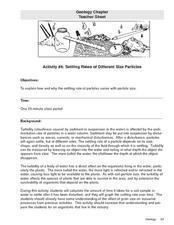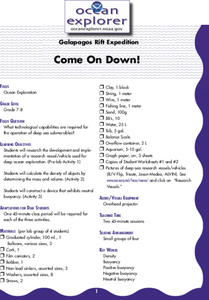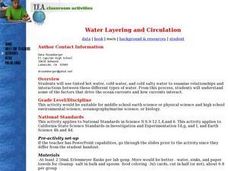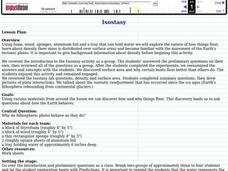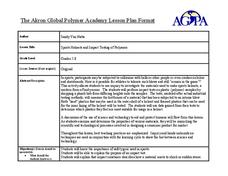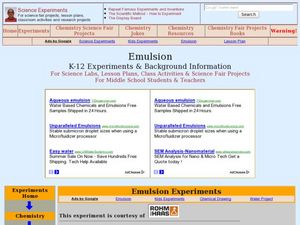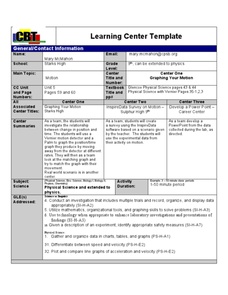Curated OER
Hot air Balloons
Students study how hot air balloons were created and the different types there are. In this density and lift instructional activity students build their own hot air balloon.
Curated OER
Settling Rates of Different Size Particles
High schoolers discover how and why the settling rate of particles differs with the size of the particles. Using different soil samples, they calculate the amount of time it takes for a sample to settle in water for up to forty minutes....
Curated OER
The Solar System: Why do we Explore?
Third graders act as scientists. In this property discovery lesson, 3rd graders explore the substance "Oobleck" (cornstarch, water, food coloring). They work in groups to investigate the substance and make observations as a scientist...
Curated OER
Galapagos Rift Expedition Come On Down!
Students research the development and implementation of a research vessel/vehicle used for deep ocean exploration. In this oceanography lesson, students calculate the density of objects by determining the mass and volume.
Curated OER
Life in Extreme Environments - Lakes Under Ice
Students collect chemical, physical, and biological data from a local lake throughout the year. In addition, students discuss the design of an experimental structure for water collection at several specific depths as well as assess the...
Curated OER
Hurricanes and the Importance of Wetlands
Students explain how wetlands minimize the impact of hurricanes. In this earth science lesson, students investigate how different materials affect the steam plume path. They complete their worksheet after the lab.
Curated OER
Sink or Swim
Students define density and explain how to determine the density of an object. Students participate in a demonstration that shows the differences in the densities of different liquids and how they affect the liquid's physical properties.
Curated OER
Designing a Flotation Strategy for the Purification of Recycling
Twelfth graders work in teams to design a method of recycled plastics purification by flotation. They base their design on the concept that different kinds of plastics have different densities and keep overall costs and purification time...
Curated OER
Biotechnology
Students are introduced to the topic of biotechnology. Using the internet, they research issues that have been improved or brought about because of biotechnology advancements. In groups, they participate in activities in which they...
NorthEast Ohio Geoscience Education Outreach
Investigation of Plate Boundaries
Demonstrate the movement of lithospheric plates due to convection in Earth's mantle. Learners then model the movements that occur along plate boundaries using colored clay.
Curated OER
Water Layering and Circulation
Young scholars examine relationships and interactions between different types of water. They experiment with colored water of different temperature and salinity and discuss how the results relate to real ocean currents.
Curated OER
How Big Is That Star?
Aspiring astronomers study stars. They compare stars and explain the relationship between radius, mass, and diameter. By creating a star simulation, they discover how a binary star system's orbit can cause changes in the observed...
National Nanotechnology Infrastructure Network
Understanding Wave Motion - Slinky vs. Snaky: Which Spring is Dominant?
Ride the wave to an understanding of refraction! The first in a series of two inquiry-based lessons challenges learners to create transverse waves with two different types of springs. As their wave hits an object, they observe the change...
Curated OER
Alternative Energy
Students discover the different alternative fuel sources. In this biology instructional activity, students identify the different stages of the carbon cycle. They explain the pros and cons of using alternative energy.
Curated OER
Physical/Chemical Properties of a Burning Candle
Students investigate the physical and chemical properties of a candle before and after it is lit. They conduct a burning candle experiment, and complete a KWL chart and worksheet, recording the results of the investigation.
Curated OER
Poetry in Motion
Sixth graders answer questions about "From a Railway Carriage." They discuss different poetical forms. They work together to write a poem about travel.
Curated OER
The Influence of Carbon Dioxide on the Chemistry of Soda
Students investigate the carbon dioxide content of different sodas. In this chemistry lesson, students explain why PET containers are preferable than HDPE for soda bottles. They collect data and graph them.
Curated OER
Weights of Objects
Students differentiate between the weights of an object on different planets. In this geometry lesson, students investigate different weights and graph their results as it relates to the different planets. They appreciate the design of...
Curated OER
Sports Helmets and Impact Testing of Polymers
Students examine the importance of good quality safety gear. In this investigative lesson, students will tests various polymers, collect data, and analyze the data to determine which polymer is best for safety helmets. They will design a...
Curated OER
Determining Acids and Bases
Students test various liquids and identify as acids or bases. In this chemistry and pH lesson, the students use purple cabbage indicator to test a variety of teacher-provided substances, then bring in liquids from home to test acidity....
Curated OER
Dying to be Thin
Students role-play scenarios in which they encounter a friend or acquaintance who may have an eating disorder and brainstorm ways to help the friend. They create informational brochures with information about eating disorder prevention.
Curated OER
Gel Electrophoresis
Students conduct a variety of experiments to explore gel electrophoresis. In this biology lesson, explain how this process separate DNA and RNA. They discuss the practical applications of this method.
Curated OER
Emulsions
Learners identify the characteristics and composition of emulsions. In this chemistry lesson, students classify household products according to emulsion type. They explain how to make the best emulsion.
Curated OER
"Graphing Your Motion"
Students study the concepts of motion, velocity, and acceleration through graphing their own movement using LoggerPro. They explain the difference between speed and velocity using the weather vane example. They discover the difference...

